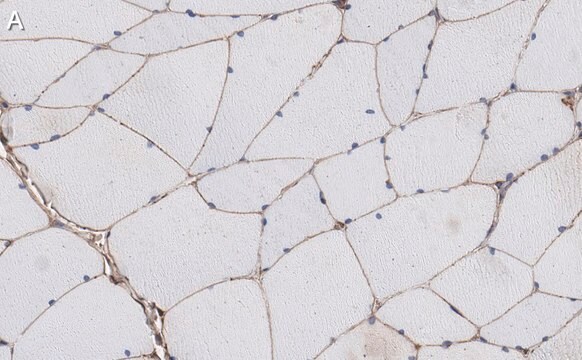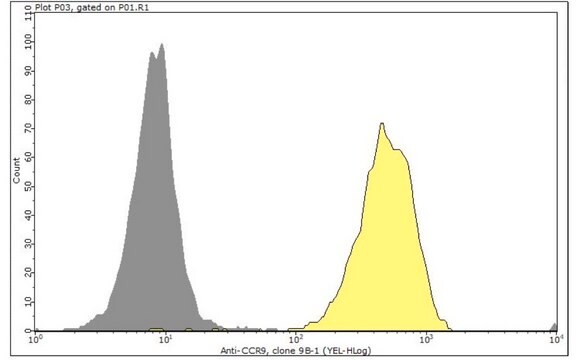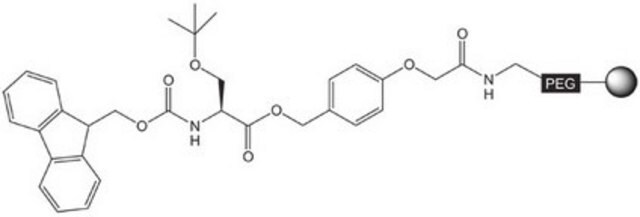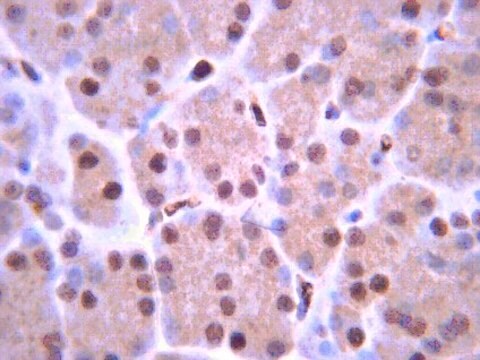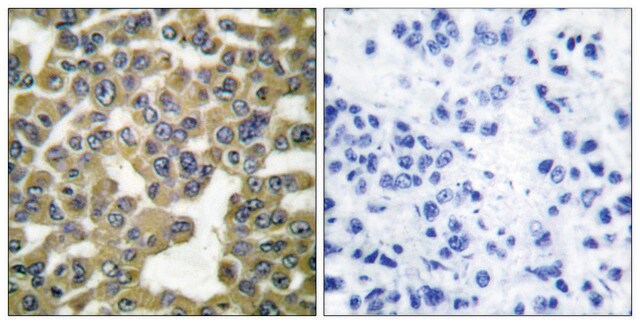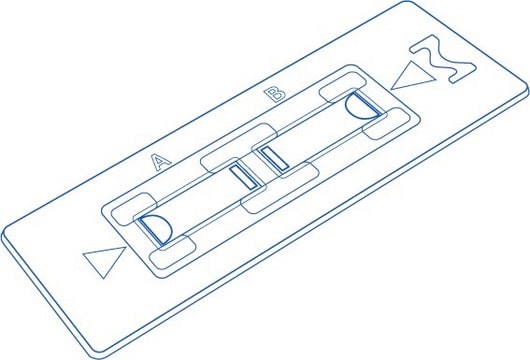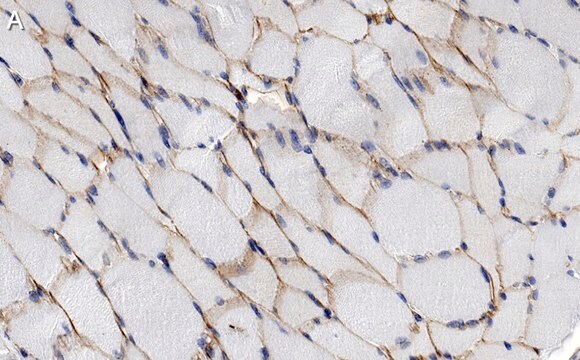推荐产品
生物源
mouse
品質等級
共軛
unconjugated
抗體表格
purified antibody
抗體產品種類
primary antibodies
無性繁殖
7D11, monoclonal
分子量
calculated mol wt 97.44 kDa
observed mol wt ~43 kDa
純化經由
using protein G
物種活性
mouse, human
物種活性(以同源性預測)
horse, porcine, bovine, feline, rat, Xenopus, canine
包裝
antibody small pack of 100 μg
技術
immunocytochemistry: suitable
immunofluorescence: suitable
western blot: suitable
同型
IgG1
表位序列
C-terminal
Protein ID登錄號
UniProt登錄號
運輸包裝
ambient
目標翻譯後修改
unmodified
基因資訊
mouse ... Ccr9(12769)
一般說明
Dystroglycan (UniProt: Q14118; also known as Dystrophin-associated glycoprotein 1) is encoded by the DAG1 gene (Gene ID: 1605) in human. The dystroglycan complex is involved in a number of processes including laminin and basement membrane assembly, sarcolemmal stability, cell survival, peripheral nerve myelination, nodal structure, cell migration, and epithelial polarization. It also serves as an adhesion molecule and links the extracellular matrix to the intracellular actin cytoskeleton. Its expression is reported in a variety of fetal and adult tissues. It is synthesized with a signal peptide (aa 1-29) that is subsequently cleaved off to generate the mature protein that is further autolytically cleaved (between 653-654) to produce -dystroglycan (aa 30-653) and β-dystroglycan (aa 654-895). -dystroglycan is an extracellular peripheral glycoprotein that binds to several extracellular matrix and synaptic proteins such as laminin-2 and 5, agrin, neurexin, and pikachurin. It is heavily O-glycosylated, which comprises of up to two thirds of its mass and the carbohydrate composition differs depending on tissue type. It is reported that its O-mannosyl glycosylation is required for its ligand- binding functions. It plays important roles in the deposition, organization, and stability of basement membranes. β-dystroglycan is a single-pass type 1 transmembrane protein with its cytoplasmic tail bound to utrophin or dystrophin. It plays important roles in connecting the extracellular matrix to the cytoskeleton and serves as a cell adhesion receptor in both muscle and non-muscle tissues. In the cell, β-dystroglycan binds to dystrophin that is linked to actin cytoskeleton. Hence, /β- dystroglycans act as a molecular axis connecting extracellular matrix with the cytoskeleton across the plasma membrane. Defects in O-mannosyl glycan have been linked to various congenital muscular dystrophies caused by aberrant -dystroglycan glycosylation. (Ref.: Alonso-Rangel, L., et al. (2017). Life Sci. 182; 1-9; Yoon, JH., et al. (2012). J Proteome Res. 11(9); 4413-4424).
特異性
Clone 7D11 is a mouse monoclonal antibody that detects β-Dystroglycan. It targets an epitope within 15 amino acids from the C-terminal region.
免疫原
A linear peptide corresponding to 15 amino acids from the C-terminal region of human β-Dystroglycan.
應用
Quality Control Testing
Evaluated by Western Blotting in HeLa cell lysates.
Western Blotting Analysis: A 1:1,000 dilution of this antibody detected β-Dystroglycan in HeLa cell lysates.
Tested Applications
Immunocytochemistry Analysis: A representative lot detected β-Dystroglycan in Immunocytochemistry applications (Azuara-Medina, P.M., et al. (2019). Cell Death Dis. 10(3):196).
Western Blotting Analysis: A representative lot detected β-Dystroglycan in Western Blotting applications (Sherman, D.L., et al. (2001). Neuron. 30(3):677-87; Acharyya, S., et al. (2005). Cancer Cell. 8(5):421-32; Azuara-Medina, P.M., et al. (2019). Cell Death Dis. 10(3):196; Alonso-Rangel, L., et al. (2017). Life Sci. 182:1-9).
Immunofluorescence Analysis: A representative lot detected β-Dystroglycan in Immunofluorescence applications (Sherman, D.L., et al. (2001). Neuron. 30(3):677-87; Acharyya, S., et al. (2005). Cancer Cell. 8(5):421-32; Azuara-Medina, P.M., et al. (2019). Cell Death Dis.10(3):196; Moretti, A., et al. (2020). Nat Med. 26(2):207-214).
Note: Actual optimal working dilutions must be determined by end user as specimens, and experimental conditions may vary with the end user
Evaluated by Western Blotting in HeLa cell lysates.
Western Blotting Analysis: A 1:1,000 dilution of this antibody detected β-Dystroglycan in HeLa cell lysates.
Tested Applications
Immunocytochemistry Analysis: A representative lot detected β-Dystroglycan in Immunocytochemistry applications (Azuara-Medina, P.M., et al. (2019). Cell Death Dis. 10(3):196).
Western Blotting Analysis: A representative lot detected β-Dystroglycan in Western Blotting applications (Sherman, D.L., et al. (2001). Neuron. 30(3):677-87; Acharyya, S., et al. (2005). Cancer Cell. 8(5):421-32; Azuara-Medina, P.M., et al. (2019). Cell Death Dis. 10(3):196; Alonso-Rangel, L., et al. (2017). Life Sci. 182:1-9).
Immunofluorescence Analysis: A representative lot detected β-Dystroglycan in Immunofluorescence applications (Sherman, D.L., et al. (2001). Neuron. 30(3):677-87; Acharyya, S., et al. (2005). Cancer Cell. 8(5):421-32; Azuara-Medina, P.M., et al. (2019). Cell Death Dis.10(3):196; Moretti, A., et al. (2020). Nat Med. 26(2):207-214).
Note: Actual optimal working dilutions must be determined by end user as specimens, and experimental conditions may vary with the end user
Anti-β-Dystroglycan, clone 7D11, Cat. No. MABT1546, is a mouse monoclonal antibody that detects β-Dystroglycan and is tested for use in Immunocytochemistry, Immunofluorescence, and Western Blotting.
外觀
Purified mouse monoclonal antibody IgG1 in buffer containing 0.1 M Tris-Glycine (pH 7.4), 150 mM NaCl with 0.05% sodium azide.
儲存和穩定性
Recommended storage: +2°C to +8°C.
其他說明
Concentration: Please refer to the Certificate of Analysis for the lot-specific concentration.
免責聲明
Unless otherwise stated in our catalog or other company documentation accompanying the product(s), our products are intended for research use only and are not to be used for any other purpose, which includes but is not limited to, unauthorized commercial uses, in vitro diagnostic uses, ex vivo or in vivo therapeutic uses or any type of consumption or application to humans or animals.
未找到合适的产品?
试试我们的产品选型工具.
儲存類別代碼
12 - Non Combustible Liquids
水污染物質分類(WGK)
WGK 1
我们的科学家团队拥有各种研究领域经验,包括生命科学、材料科学、化学合成、色谱、分析及许多其他领域.
联系技术服务部门